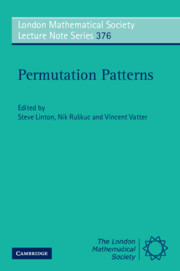Book contents
- Frontmatter
- Contents
- Preface
- Some general results in combinatorial enumeration
- A survey of simple permutations
- Permuting machines and permutation patterns
- On three different notions of monotone subsequences
- A survey on partially ordered patterns
- Generalized permutation patterns – a short survey
- An introduction to structural methods in permutation patterns
- Combinatorial properties of permutation tableaux
- Enumeration schemes for words avoiding permutations
- The lexicographic first occurrence of a I-II-III-pattern
- Enumeration of partitions by rises, levels and descents
- Restricted patience sorting and barred pattern avoidance
- Permutations with k-regular descent patterns
- Packing rates of measures and a conjecture for the packing density of 2413
- On the permutational power of token passing networks
- Problems and conjectures
- References
Enumeration of partitions by rises, levels and descents
Published online by Cambridge University Press: 05 October 2010
- Frontmatter
- Contents
- Preface
- Some general results in combinatorial enumeration
- A survey of simple permutations
- Permuting machines and permutation patterns
- On three different notions of monotone subsequences
- A survey on partially ordered patterns
- Generalized permutation patterns – a short survey
- An introduction to structural methods in permutation patterns
- Combinatorial properties of permutation tableaux
- Enumeration schemes for words avoiding permutations
- The lexicographic first occurrence of a I-II-III-pattern
- Enumeration of partitions by rises, levels and descents
- Restricted patience sorting and barred pattern avoidance
- Permutations with k-regular descent patterns
- Packing rates of measures and a conjecture for the packing density of 2413
- On the permutational power of token passing networks
- Problems and conjectures
- References
Summary
Abstract
A descent in a permutation α1α2 · αn is an index i for which αi > αi+1. The number of descents in a permutation is a classical permutation statistic which was first studied by P. A. MacMahon almost a hundred years ago, and it still plays an important role in the study of permutations. Representing set partitions by equivalent canonical sequences of integers, we study this statistic among the set partitions, as well as the numbers of rises and levels. We enumerate set partitions with respect to these statistics by means of generating functions, and present some combinatorial proofs. Applications are obtained to new combinatorial results and previously-known ones.
Introduction
A descent in a permutation α = α1α2 ··· αn is an index i for which αi > αi+1. The number of descents in a permutation is a classical permutation statistic. This statistic was first studied by MacMahon, and it still plays an important role in the study of permutation statistics. In this paper we study the statistics of numbers of rises, levels and descents among set partitions expressed as canonical sequences, defined below.
- Type
- Chapter
- Information
- Permutation Patterns , pp. 221 - 232Publisher: Cambridge University PressPrint publication year: 2010
References
- 1
- Cited by



